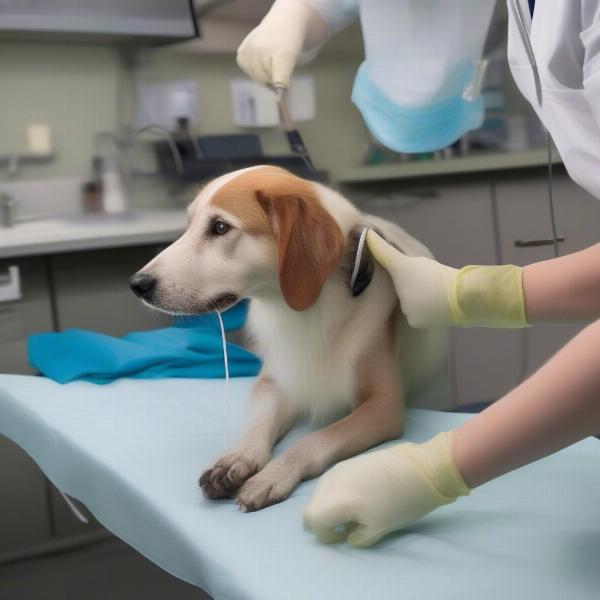A Penrose drain is a soft, flexible rubber tube used to remove fluid or pus from a wound or surgical site in dogs. It’s a common post-operative tool that helps prevent infection and promotes healing. This article will delve into everything you need to know about Penrose drains in dogs, from why they’re used to how to care for them at home.
Why Are Penrose Drains Used in Dogs?
Penrose drains are crucial in managing fluid buildup, which can create a breeding ground for bacteria. Veterinarians often use them after surgeries where dead space is created, like abscess removals, or where significant inflammation is expected. By providing an exit route for fluids, the drain minimizes swelling, reduces pressure on tissues, and facilitates faster healing.
Caring for a Dog with a Penrose Drain
Your veterinarian will provide detailed instructions on caring for your dog’s Penrose drain at home. This usually involves cleaning the area around the drain with a prescribed antiseptic solution several times a day. It’s also important to monitor the amount and type of drainage. While some drainage is expected, excessive bleeding, a foul odor, or changes in the drainage color should be reported to your vet immediately.
Potential Complications of Penrose Drains in Dogs
While Penrose drains are generally safe, complications can arise. These include premature removal of the drain, blockage of the drain, infection around the drain site, or excessive tissue reaction. Regular monitoring and diligent care are crucial to minimize these risks.
When Will the Penrose Drain Be Removed?
The duration a Penrose drain remains in place varies depending on the individual case and the underlying condition. Your veterinarian will schedule a follow-up appointment to assess the healing progress and remove the drain once the drainage has significantly decreased or stopped.
 Veterinarian removing a Penrose drain from a dog
Veterinarian removing a Penrose drain from a dog
Frequently Asked Questions about Penrose Drains in Dogs
- Is it normal for my dog to lick the drain site? While licking can be soothing, it can also introduce bacteria and disrupt the healing process. An Elizabethan collar can prevent your dog from accessing the drain.
- What should I do if the drain falls out? Contact your veterinarian immediately. They will advise on the next steps, which may involve replacing the drain.
- How do I know if the drain is infected? Signs of infection include redness, swelling, increased pain, pus, and a foul odor.
- Can my dog exercise with a drain? Limited activity is recommended to prevent pulling or dislodging the drain. Follow your veterinarian’s instructions on exercise restrictions.
- How painful is it for a dog to have a Penrose drain? While the drain itself may cause some discomfort, your veterinarian will likely prescribe pain medication to manage any pain.
- What should the drainage look like? Initially, the drainage may be bloody or serosanguinous (blood-tinged). It should gradually become less bloody and more serous (clear or straw-colored) over time.
- How do I clean the drain? Clean the area around the drain with the prescribed antiseptic solution, being careful not to tug on the drain itself.
Conclusion
Penrose drains play a vital role in promoting healing after certain surgeries or procedures in dogs. While they require some extra care, they can significantly reduce the risk of complications. By following your veterinarian’s instructions and monitoring your dog closely, you can ensure a smooth recovery. If you have any concerns about your dog’s Penrose drain, always consult your veterinarian.
ILM Dog is a leading international pet website specializing in dog care and breeding. We offer expert advice on a range of topics, including Dog Breeds and Selection, Dog Health and Medical Care, Dog Training and Behavior, Dog Nutrition and Feeding, Dog Grooming and Hygiene, and Dog Products and Accessories. For more information and personalized advice, contact us at [email protected] or +44 20-3965-8624. Visit ILM Dog for more valuable resources and expert guidance on all aspects of dog care.